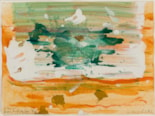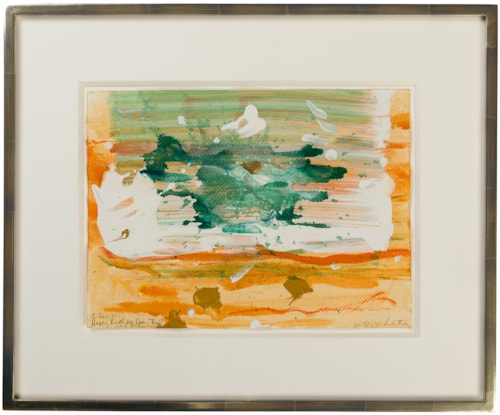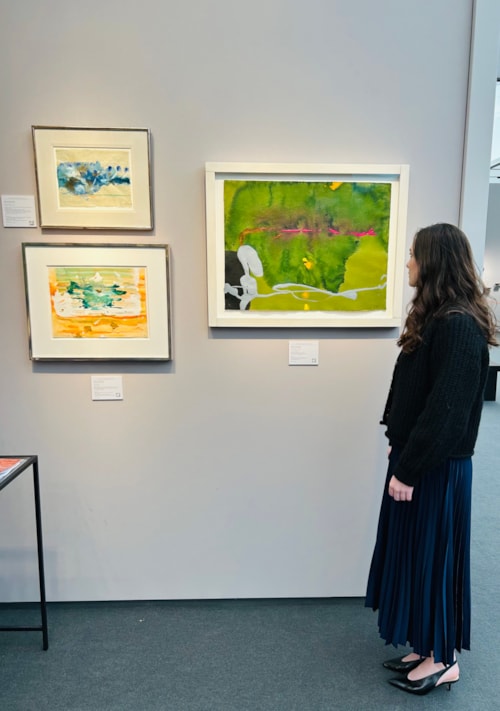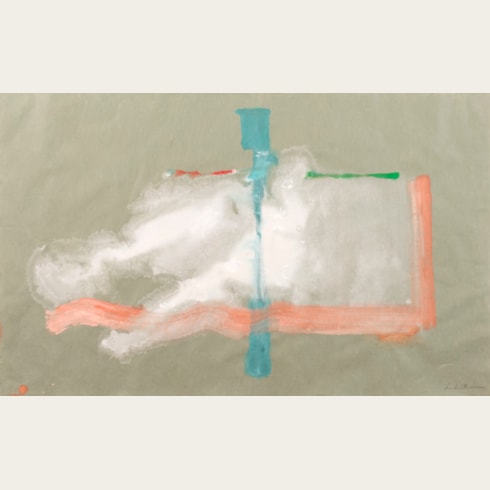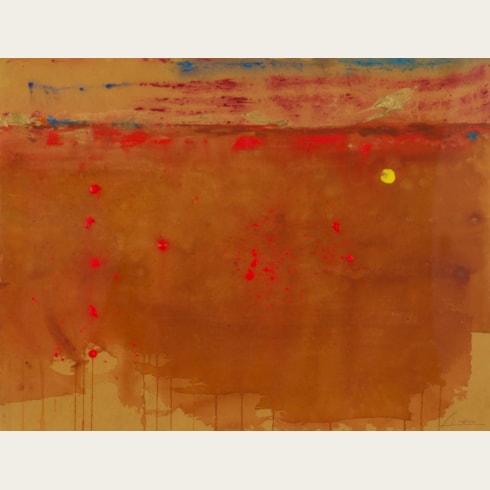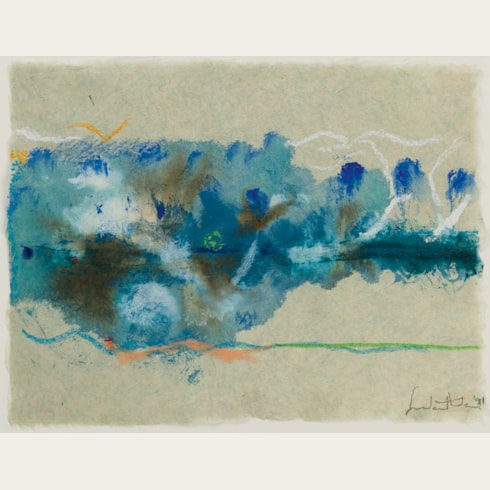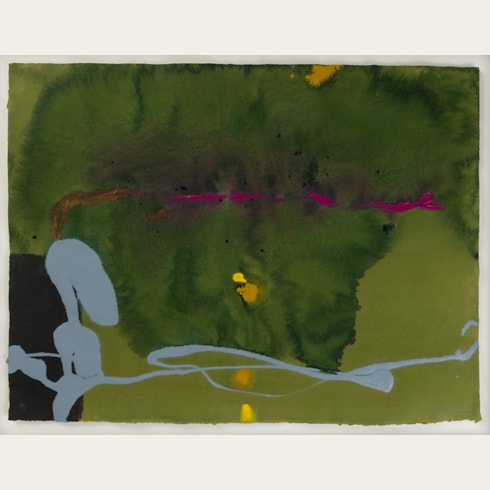Helen FRANKENTHALER
(New York 1928 - Darien 2011)
Untitled, 1981
Sold
Acrylic on paper.
Signed and dated 22 July ’81 Frankenthaler in pencil at the lower right.
Signed, dated and dedicated 2 Dec ’81 / Happy Birthday Dear Erni! / Love Helen in pencil at the lower left.
279 x 381 mm. (11 x 15 in.)
Signed and dated 22 July ’81 Frankenthaler in pencil at the lower right.
Signed, dated and dedicated 2 Dec ’81 / Happy Birthday Dear Erni! / Love Helen in pencil at the lower left.
279 x 381 mm. (11 x 15 in.)
Helen Frankenthaler produced a large and varied body of vibrant works on paper – drawn in ink, crayon, gouache, watercolour, oil, acrylic and pastel - throughout her long and storied career. Her drawings have been aptly described as ‘among her most spontaneous and personal works’ and were almost always produced as autonomous works in their own right, rather than as preparatory exercises towards paintings or prints. As early as 1967, Frankenthaler was stressing the significance of drawing as well as colour in her work: ‘My conscious interest was more in drawing and the drawing of color than in color alone.’
As the art historian and curator John Elderfield has noted of Frankenthaler’s unique works in watercolour, acrylics or gouache, ‘her works on paper…after the early 1970s are conceived within the discipline of painting to a greater extent than they were before. As a result they usually seem more finished and perfected than the earlier works on paper; but they also seem more like paintings than drawings and therefore more demanding than before of comparison with the larger paintings, of which they can seem at times somewhat too beautifully finished and perfected variants…The vast majority of the very many works on paper that Frankenthaler has made since the early 1970s are superb within their own terms. Some are superb within painting’s terms too. Some, which are the most successful of all, are those whose own terms are not painting’s, not entirely.’
The first owners of the present sheet were Barbara (1933-2018) and Ernest (1932-2021) Kafka, an intellectual couple from New York who spent their summers in Provincetown, Massachusetts. The Kafkas befriended several members of the vibrant local artistic community in Provincetown, notably Frankenthaler and her husband Robert Motherwell, as well as Lucas Samaras and Frank Stella. (Frankenthaler had first visited Provincetown in 1957, and established a studio there in 1961, returning every summer that decade.) The close friendship between Frankenthaler and Barbara and Ernest Kafka led the artist to gift several works, on both paper and canvas, to the couple. Drawn in acrylic on paper in July 1981, the present sheet was given by the artist four months later to Ernest Kafka, on the occasion of his 49th birthday.
As the art historian Karen Wilkin has noted of the artist’s works on paper of the late 1970s and early 1980s, ‘Frankenthaler places unprecedented emphasis on inflected expanses of color, on nuances of dark and light, of transparency and opacity, and on a new, heightened physicality. The impact of these pictures comes neither from drawing nor from graphic configurations, as in the works of the 1950s and 1960s, but rather from the fact of painting and the special qualities of paint...Some of the new painterliness of Frankenthaler’s works on paper of the last ten years is the result of her using acrylic paint but without [any] additives...Frankenthaler’s works on paper have always demonstrated her dialogue with her materials: the transparency of her watercolors of the 1950s or the haloing stains and declarative shapes of her oils on paper of the 1960s were expressive of the peculiarities of their media. The new surface variation of her works on paper of the past decade is her response to acrylic’s properties. Thinned, it flows and is as transparent as watercolor; thick, it holds its shape and retains the imprint of the tool that manipulates it, like oil. Yet it is more intense than watercolor when thinned, and unlike oil, it produces no encircling stain…These are sensuously worked paintings on paper that combine the immediacy, clarity, and directness of Frankenthaler’s most transparent early works with a new, vigorous physicality.’
As the art historian and curator John Elderfield has noted of Frankenthaler’s unique works in watercolour, acrylics or gouache, ‘her works on paper…after the early 1970s are conceived within the discipline of painting to a greater extent than they were before. As a result they usually seem more finished and perfected than the earlier works on paper; but they also seem more like paintings than drawings and therefore more demanding than before of comparison with the larger paintings, of which they can seem at times somewhat too beautifully finished and perfected variants…The vast majority of the very many works on paper that Frankenthaler has made since the early 1970s are superb within their own terms. Some are superb within painting’s terms too. Some, which are the most successful of all, are those whose own terms are not painting’s, not entirely.’
The first owners of the present sheet were Barbara (1933-2018) and Ernest (1932-2021) Kafka, an intellectual couple from New York who spent their summers in Provincetown, Massachusetts. The Kafkas befriended several members of the vibrant local artistic community in Provincetown, notably Frankenthaler and her husband Robert Motherwell, as well as Lucas Samaras and Frank Stella. (Frankenthaler had first visited Provincetown in 1957, and established a studio there in 1961, returning every summer that decade.) The close friendship between Frankenthaler and Barbara and Ernest Kafka led the artist to gift several works, on both paper and canvas, to the couple. Drawn in acrylic on paper in July 1981, the present sheet was given by the artist four months later to Ernest Kafka, on the occasion of his 49th birthday.
As the art historian Karen Wilkin has noted of the artist’s works on paper of the late 1970s and early 1980s, ‘Frankenthaler places unprecedented emphasis on inflected expanses of color, on nuances of dark and light, of transparency and opacity, and on a new, heightened physicality. The impact of these pictures comes neither from drawing nor from graphic configurations, as in the works of the 1950s and 1960s, but rather from the fact of painting and the special qualities of paint...Some of the new painterliness of Frankenthaler’s works on paper of the last ten years is the result of her using acrylic paint but without [any] additives...Frankenthaler’s works on paper have always demonstrated her dialogue with her materials: the transparency of her watercolors of the 1950s or the haloing stains and declarative shapes of her oils on paper of the 1960s were expressive of the peculiarities of their media. The new surface variation of her works on paper of the past decade is her response to acrylic’s properties. Thinned, it flows and is as transparent as watercolor; thick, it holds its shape and retains the imprint of the tool that manipulates it, like oil. Yet it is more intense than watercolor when thinned, and unlike oil, it produces no encircling stain…These are sensuously worked paintings on paper that combine the immediacy, clarity, and directness of Frankenthaler’s most transparent early works with a new, vigorous physicality.’
Born into a life of privilege on the Upper East Side of Manhattan, the American painter, draughtsman and printmaker Helen Frankenthaler was educated at Horace Mann, Brearley and the Dalton School in New York (where her first art teacher was the Mexican painter Rufino Tamayo), before completing her studies with the painter Paul Feeley at Bennington College in Vermont. Her early work was strongly influenced by the paintings of Willem de Kooning and Arshile Gorky, as well as the earlier work of Wassily Kandinsky and Joan Miró. Soon after setting up her studio in New York in 1951 Frankenthaler became close friends with the eminent art critic Clement Greenberg, with whom she was to be in a relationship for several years. When the painter Adolph Gottlieb saw her paintings at Greenberg’s apartment, he included a work by her in his selection for a group exhibition at the Kootz Gallery in 1950. The following year Frankenthaler was the youngest artist to be included in the Ninth Street Show, an exhibition organized by members of the New York School (also known as The Club), while later that year the twenty-three-year old artist had her first solo show, of eleven paintings, at the Tibor de Nagy Gallery.
Perhaps the most significant event of this period, however, was Frankenthaler’s discovery of the work of Jackson Pollock, initially at his exhibition at the Betty Parsons Gallery in 1950. Greenberg introduced her to Pollock the following year, and she began closely studying his methods on visits to his studio in Long Island. The influence of Pollock on her own paintings was to be significant. As noted by the scholar Barbara Rose, in the first published monograph devoted to Frankenthaler’s work, ‘The overt physicality of Pollock’s method, the sense of the painting having been, as Frankenthaler puts it, “choreographed”, made possible a large scale, a boldness and an openness that appealed to her.’ By the end of 1951 Frankenthaler had become a part of the vibrant artistic community in New York, although younger than almost all of her contemporaries. She became friendly with Pollock and Lee Krasner, as well as with Gottlieb, Willem and Elaine de Kooning, Grace Hartigan, Franz Kline, Joan Mitchell, Barnett Newman and David Smith.
In October 1952, after a trip to Nova Scotia with Greenberg, Frankenthaler painted a monumental canvas she titled Mountains and Sea, in which her characteristic stain technique first came to the fore. The painting, the largest she had attempted up to that point, became of seminal importance in heralding the direction of the artist’s later career. She had already experimented with working on the floor rather than on a painting on an easel. Now Frankenthaler began pouring and spilling paint directly onto raw, unprimed canvas. In the spring of 1953 the older painters Kenneth Noland and Morris Louis visited Frankenthaler’s studio and came away impressed with what they had seen. The three painters were soon making regular studio visits to each other, and Frankenthaler’s work was to be an influence on Louis and Noland’s development of Color Field painting.
Frankenthaler’s work began to receive more attention as she continued to have one-man exhibitions at the Tibor de Nagy Gallery between 1953 and 1958, and also had her work included in museum shows. In 1958 she married the artist Robert Motherwell, and two years later an early retrospective exhibition of her work, curated by the poet and art critic Frank O’Hara, was mounted at the Jewish Museum in New York. By this time her paintings had been acquired by the Whitney Museum of American Art and the Museum of Modern Art in New York, while in 1959 she had been represented in the Documenta II exhibition in Kassel and biennials in Paris and São Paolo. At the age of thirty, Frankenthaler was now firmly established as one of the leading painters of the second generation of the New York school of abstract painters.
Solo gallery shows of her work - in New York, Los Angeles, Paris, London and elsewhere - continued throughout the 1960s, as did several important museum surveys in which her paintings were included. (She also occasionally taught fine art classes and seminars and gave lectures during this period.) Frankenthaler was one of three artists chosen to represent the United States at the Venice Bienniale of 1966, and in 1969 was the subject of a major retrospective exhibition at the Whitney Museum in New York; a show that later travelled to England and Germany and introduced her work to a much wider public abroad. This success continued throughout the 1970s with a number of museum and gallery exhibitions, as well as some public mural commissions, executed as paintings, ceramic tiles or tapestry. She also began working productively as a printmaker at this time, producing etchings, monotypes, lithographs and colour woodcuts; the latter in particular took up much of her time in the 1990s.
Helen Frankenthaler has said that ‘A really good picture looks as if it’s happened at once. It’s an immediate image. For my own work, when a picture looks labored and overworked, and you can read in it – well, she did this and then she did that, and then she did that – there is something in it that has not got to do with beautiful art to me. And I usually throw those out, though I think very often it takes ten of those over-labored efforts to produce one really beautiful wrist motion that is synchronized with your head and heart, and you have it, and therefore it looks as if it were born in a minute.’
Perhaps the most significant event of this period, however, was Frankenthaler’s discovery of the work of Jackson Pollock, initially at his exhibition at the Betty Parsons Gallery in 1950. Greenberg introduced her to Pollock the following year, and she began closely studying his methods on visits to his studio in Long Island. The influence of Pollock on her own paintings was to be significant. As noted by the scholar Barbara Rose, in the first published monograph devoted to Frankenthaler’s work, ‘The overt physicality of Pollock’s method, the sense of the painting having been, as Frankenthaler puts it, “choreographed”, made possible a large scale, a boldness and an openness that appealed to her.’ By the end of 1951 Frankenthaler had become a part of the vibrant artistic community in New York, although younger than almost all of her contemporaries. She became friendly with Pollock and Lee Krasner, as well as with Gottlieb, Willem and Elaine de Kooning, Grace Hartigan, Franz Kline, Joan Mitchell, Barnett Newman and David Smith.
In October 1952, after a trip to Nova Scotia with Greenberg, Frankenthaler painted a monumental canvas she titled Mountains and Sea, in which her characteristic stain technique first came to the fore. The painting, the largest she had attempted up to that point, became of seminal importance in heralding the direction of the artist’s later career. She had already experimented with working on the floor rather than on a painting on an easel. Now Frankenthaler began pouring and spilling paint directly onto raw, unprimed canvas. In the spring of 1953 the older painters Kenneth Noland and Morris Louis visited Frankenthaler’s studio and came away impressed with what they had seen. The three painters were soon making regular studio visits to each other, and Frankenthaler’s work was to be an influence on Louis and Noland’s development of Color Field painting.
Frankenthaler’s work began to receive more attention as she continued to have one-man exhibitions at the Tibor de Nagy Gallery between 1953 and 1958, and also had her work included in museum shows. In 1958 she married the artist Robert Motherwell, and two years later an early retrospective exhibition of her work, curated by the poet and art critic Frank O’Hara, was mounted at the Jewish Museum in New York. By this time her paintings had been acquired by the Whitney Museum of American Art and the Museum of Modern Art in New York, while in 1959 she had been represented in the Documenta II exhibition in Kassel and biennials in Paris and São Paolo. At the age of thirty, Frankenthaler was now firmly established as one of the leading painters of the second generation of the New York school of abstract painters.
Solo gallery shows of her work - in New York, Los Angeles, Paris, London and elsewhere - continued throughout the 1960s, as did several important museum surveys in which her paintings were included. (She also occasionally taught fine art classes and seminars and gave lectures during this period.) Frankenthaler was one of three artists chosen to represent the United States at the Venice Bienniale of 1966, and in 1969 was the subject of a major retrospective exhibition at the Whitney Museum in New York; a show that later travelled to England and Germany and introduced her work to a much wider public abroad. This success continued throughout the 1970s with a number of museum and gallery exhibitions, as well as some public mural commissions, executed as paintings, ceramic tiles or tapestry. She also began working productively as a printmaker at this time, producing etchings, monotypes, lithographs and colour woodcuts; the latter in particular took up much of her time in the 1990s.
Helen Frankenthaler has said that ‘A really good picture looks as if it’s happened at once. It’s an immediate image. For my own work, when a picture looks labored and overworked, and you can read in it – well, she did this and then she did that, and then she did that – there is something in it that has not got to do with beautiful art to me. And I usually throw those out, though I think very often it takes ten of those over-labored efforts to produce one really beautiful wrist motion that is synchronized with your head and heart, and you have it, and therefore it looks as if it were born in a minute.’
Provenance
Gifted by the artist in December 1981 to Ernest and Barbara Kafka, New York and Provincetown, Massachusetts
Their posthumous sale (‘A Way of Life: The Collection of Barbara and Ernest Kafka’), New York, Sotheby’s, 20 May 2022, lot 265.
Their posthumous sale (‘A Way of Life: The Collection of Barbara and Ernest Kafka’), New York, Sotheby’s, 20 May 2022, lot 265.


